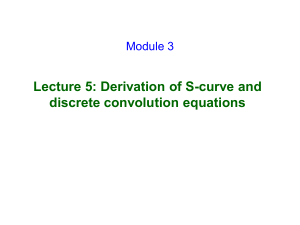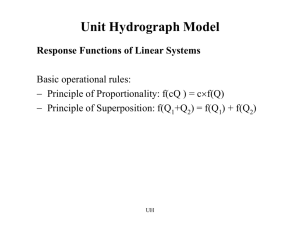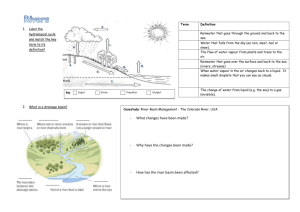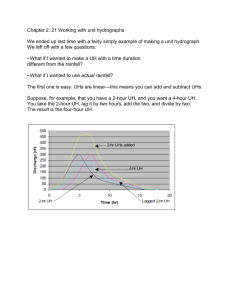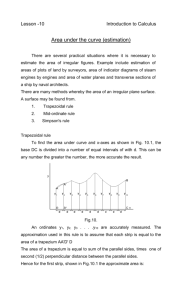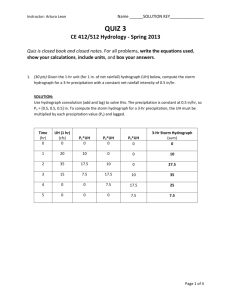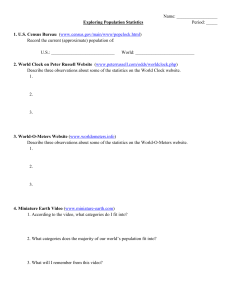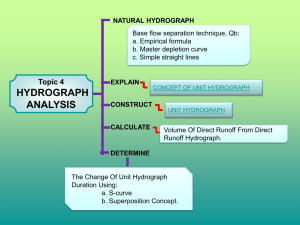Lecture 12e Hydrographs 4
advertisement
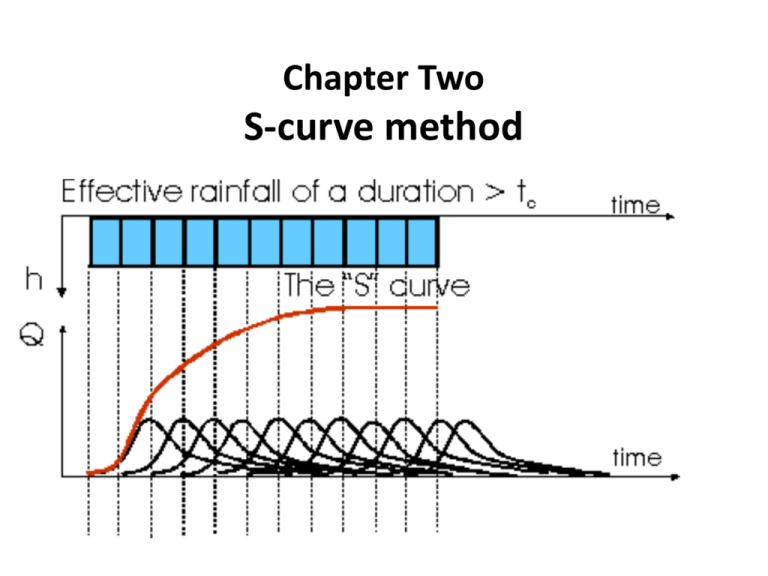
Chapter Two S-curve method UH Lagging A UH has a particular duration, D. Unit hydrographs are linear, they can be added, for example, to generate a hydrograph for a storm 2x, 3x, 4x, etc. … longer 1–hr UH 2–hr UH The linear property of a UH can be used to generate a UH of a larger duration. Here two copies of a 1-hour UH are lagged by 1-hr and added, then the ordinates are divided by 2, to make a 2-hour UH (1 inch over two hours). However this lagging method is restricted to integer multiples of the original duration. S –curve method S –curve method works for any duration. The first step is to add a series of UH’s of duration D, each lagged by time period D, This corresponds to the runoff hydrograph from a continuous rainfall excess intensity of 1/D inches/hour. S –curve method works for any duration, D’ By shifting a copy of the S-curve by D’ hours, and subtracting the ordinates, the resulting hydrograph (dashed line - - - - - - ) must be due to rainfall of intensity 1/D inches/hour that lasts for a duration of D’ hours. To convert the hydrograph (dashed line - - - - -) to a UH, multiply ordinates by D/D’ ,resulting in a UH of duration D’. D’ need NOT be an integral multiple of D. Example 2-4 • Convert the following 2-hr UH to a 3-hr UH using the S-curve Method ____________________________________________________ TIME (hr) 2-hr UH Ordinate (cfs)________ . 0 0 1 75 2 250 3 300 4 275 5 200 6 100 7 75 8 50 9 25 10 0 • Make a spreadsheet with the 2-hr UH ordinates, then copy them in the next column lagged by D=2 hours. Keep adding columns until the row sums are fairly constant. The sums are the ordinates of your S-curve. Draw your S-curve, it looks like the upper curve. Figure E2-4 • Copy your S-curve ordinates into a new spreadsheet, then copy the same ordinates D’=3 time units down. Calculate the difference, then multiply by D/D’ ,here = 2/3, to get your 3 hour UH. Why multiply by a correction factor? • Here the original UH was for a 2-hour storm, and we need a UH for a 3-hour storm. • A 2-hour UH is for a storm with 1/2 in/hr for 2 hours • A 3-hour UH is for a storm with 1/3 in/hr for 3 hours • 1/2 x 2/3 = 1/3 • For each s-curves difference of lagged UHs , multiply the ordinates by D /D’ to get the correct UH Review of this method • Let’s look at the example again. • Here are the two copies of your S-curve based on a sum of 2-hr UHs. The second copy is lagged by D’=3 hours. • Calculate the difference, and re-scale the difference by D/D’ • Plot the new ordinates, and here is your new 3 hour UH, or whatever D’ you need Prediction • This method provides a hydrograph that predicts the behavior of a flood from a storm of any duration
